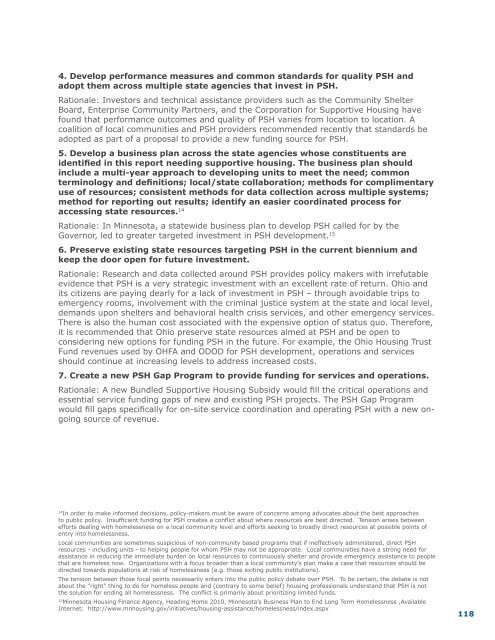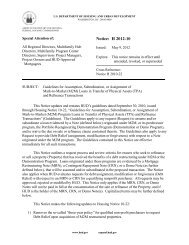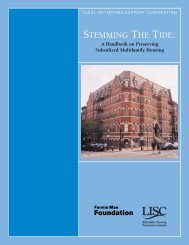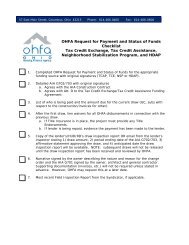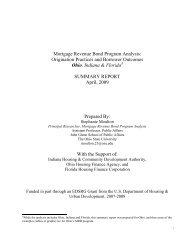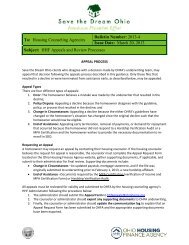OHFA Annual Plan - Ohio Housing Finance Agency
OHFA Annual Plan - Ohio Housing Finance Agency
OHFA Annual Plan - Ohio Housing Finance Agency
You also want an ePaper? Increase the reach of your titles
YUMPU automatically turns print PDFs into web optimized ePapers that Google loves.
4. Develop performance measures and common standards for quality PSH andadopt them across multiple state agencies that invest in PSH.Rationale: Investors and technical assistance providers such as the Community ShelterBoard, Enterprise Community Partners, and the Corporation for Supportive <strong>Housing</strong> havefound that performance outcomes and quality of PSH varies from location to location. Acoalition of local communities and PSH providers recommended recently that standards beadopted as part of a proposal to provide a new funding source for PSH.5. Develop a business plan across the state agencies whose constituents areidentified in this report needing supportive housing. The business plan shouldinclude a multi-year approach to developing units to meet the need; commonterminology and definitions; local/state collaboration; methods for complimentaryuse of resources; consistent methods for data collection across multiple systems;method for reporting out results; identify an easier coordinated process foraccessing state resources. 14Rationale: In Minnesota, a statewide business plan to develop PSH called for by theGovernor, led to greater targeted investment in PSH development. 156. Preserve existing state resources targeting PSH in the current biennium andkeep the door open for future investment.Rationale: Research and data collected around PSH provides policy makers with irrefutableevidence that PSH is a very strategic investment with an excellent rate of return. <strong>Ohio</strong> andits citizens are paying dearly for a lack of investment in PSH – through avoidable trips toemergency rooms, involvement with the criminal justice system at the state and local level,demands upon shelters and behavioral health crisis services, and other emergency services.There is also the human cost associated with the expensive option of status quo. Therefore,it is recommended that <strong>Ohio</strong> preserve state resources aimed at PSH and be open toconsidering new options for funding PSH in the future. For example, the <strong>Ohio</strong> <strong>Housing</strong> TrustFund revenues used by <strong>OHFA</strong> and ODOD for PSH development, operations and servicesshould continue at increasing levels to address increased costs.7. Create a new PSH Gap Program to provide funding for services and operations.Rationale: A new Bundled Supportive <strong>Housing</strong> Subsidy would fill the critical operations andessential service funding gaps of new and existing PSH projects. The PSH Gap Programwould fill gaps specifically for on-site service coordination and operating PSH with a new ongoingsource of revenue.14In order to make informed decisions, policy-makers must be aware of concerns among advocates about the best approachesto public policy. Insufficient funding for PSH creates a conflict about where resources are best directed. Tension arises betweenefforts dealing with homelessness on a local community level and efforts seeking to broadly direct resources at possible points ofentry into homelessness.Local communities are sometimes suspicious of non-community based programs that if ineffectively administered, direct PSHresources - including units - to helping people for whom PSH may not be appropriate. Local communities have a strong need forassistance in reducing the immediate burden on local resources to continuously shelter and provide emergency assistance to peoplethat are homeless now. Organizations with a focus broader than a local community’s plan make a case that resources should bedirected towards populations at risk of homelessness (e.g. those exiting public institutions).The tension between those focal points necessarily enters into the public policy debate over PSH. To be certain, the debate is notabout the “right” thing to do for homeless people and (contrary to some belief) housing professionals understand that PSH is notthe solution for ending all homelessness. The conflict is primarily about prioritizing limited funds.15Minnesota <strong>Housing</strong> <strong>Finance</strong> <strong>Agency</strong>, Heading Home 2010, Minnesota’s Business <strong>Plan</strong> to End Long Term Homelessness ,AvailableInternet: http://www.mnhousing.gov/initiatives/housing-assistance/homelessness/index.aspx118


